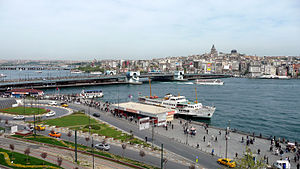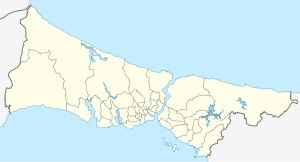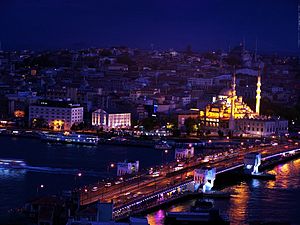Galata Bridge
Coordinates: 41 ° 1 ′ 12 ″ N , 28 ° 58 ′ 23 ″ E
| Galata Bridge | ||
|---|---|---|
| Galata Bridge with Galata Tower in the background | ||
| Crossing of | Golden Horn | |
| place | Istanbul | |
| construction | Bascule bridge | |
| overall length | 466 m | |
| width | 42 m | |
| Number of openings | a | |
| Longest span | 80 m | |
| Clear height | 6 m | |
| opening | 1992 | |
| planner | Leonhardt, Andrä and Partner | |
| location | ||
|
|
||
| Galata Bridge and view of the Historic Peninsula | ||
The Galata Bridge ( Turkish Galata Köprüsü ) crosses the Golden Horn, which flows into the Sea of Marmara, on the European side of the Bosphorus between the Istanbul districts of Eminönü in the district of Fatih and Karaköy ( Galata ) in the district of Beyoglu .
description
Today's bridge, opened in 1992, is different from its floating predecessor; it is the first bridge anchored in the underground at this point and the first bascule bridge on the Golden Horn.
The steel structure is a total of 466 m long and 42 m wide. It has two tram tracks on their own track in the middle , each flanked by three lanes for vehicles. The sidewalk on the side facing the Bosphorus is 7.5 m wide, the sidewalk on the other side, facing the Golden Horn, is 5.5 m wide. As in the past, it has a basement just above the water with restaurants, cafes and shops, which together have 6000 m² of commercial space.
The water can circulate almost unhindered under the bridge, which is supported by 114 pillars , which has contributed significantly to improving the water quality in the Golden Horn.
In the middle of the bridge there is a bascule bridge with an 80 m wide opening with 6 m clearance , through which the usual ferries can pass unhindered at any time, but which can be opened for larger ships - usually at night. The bascule bridge is framed by two large structures in which the control of the folding wings and their counterweights are located. The bascule bridge has four wings (two for each half of the roadway), which are 46 m long from its axis to the tip. Together with their 11 m long counter arm, they are a total of 57 m long. Because of the different widths of the walkways, the wings on one side are 20 m wide and those on the other side 22 m wide.
The Galata Bridge was built according to a design by Fritz Leonhardt by a consortium made up of the Turkish STFA Group and Thyssen . After a few years it had problems with the folding mechanism, which is why it could not be opened for two years. The folding wings therefore had to be temporarily removed for repairs between 2000 and 2001. After the commercial space under the carriageway had not been used for a long time, this part of the bridge has also been in operation since 2002. In 2003, the extension of the existing tram across the Galatabrücke to Neustadt was continued, so that the use of the modern bridge largely corresponds to that of its predecessor. The Galata Bridge is still one of the most heavily used parts of Istanbul by car traffic, and despite its 6 lanes it is a "bottleneck" that was only slightly relieved by the Ataturk Bridge .
history
In the 19th century, with the growth of Pera and the other suburbs north of the Golden Horn, the ferry traffic with rowboats no longer met the requirements. The wooden Old Bridge ( Cisr-i Atik , on the site of today's Ataturk Bridge ), opened by Sultan Mahmud II in 1836, no longer met the need.
At the instigation of Valide Sultan Bezm-î Âlem , the mother of Sultan Abdülmecid I , another floating bridge , the New Bridge ( Cisr-i Cedid ), was built on the site of today's Galata Bridge. In 1863 the expected visit of Emperor Napoleon III. taken as an opportunity to renew the timber construction.
In 1875 a British company built the first iron bridge. This was in turn replaced in 1912 by a new pontoon bridge with two floors, which was built by the company MAN-Werk Gustavsburg . From 1845 to 1930, the use of the bridge was not only subject to tolls for vehicles, but also for pedestrians. From 1937 to 1938, the pontoons at the MAN Gustavsburg plant were renewed and the bridge was completely refurbished. After a fire in 1992, the bridge was initially dismantled and a bridge was built from some of its parts between Balat and Hasköy , which, however, had to be removed a little later because of the adverse effects on the water exchange in the Golden Horn.
literature
- Refik Durbaş: Galata Köprüsü. İletişim, Istanbul 1995, ISBN 975-470-460-0 .
- Geert Mak: The Bridge of Istanbul. A journey between Orient and Occident (original title: De brug , translated by Andreas Ecke). Pantheon, Munich 2007, ISBN 978-3-570-55040-3 .
- Brigitte Moser , Michael W. Weithmann: A short history of Istanbul . 2nd edition, Pustet, Regensburg 2012, pp. 139 ff, ISBN 978-3-7917-2248-1 .
- Gülsün Tanyeli, Yegân Kâhya: Galata Köprüleri . In: Dünden Bugüne İstanbul Ansiklopedisi. Volume III, Istanbul 1993-1995, pp. 357-359, ISBN 975-7306-00-2 .
Web links
- Galata Bridge Istanbul on the website of Leonhardt, Andrä und Partner
- Erich Wirzberger: The Galata Bridge in Istanbul, the Biggest Bascule Bridge in the World. On heavymovablestructures.org (PDF; 1.4 MB)
- Galata Bridge on the STFA Group website, with a photo of the bridge with an open wing from when the tram was not installed.
- Photo of the opened Galata Bridge on the website of Nunteknik Inc.
- Hans-Christian Täubrich: The old tea house no longer sways - the story of the floating Galata Bridge in Istanbul. In. Culture & Technology , 1995 (PDF; 9.6 MB)
- Galata Köprüsü in Rehber Ansiklopedisi (Turkish)
- Planet Galata - A Bridge in Istanbul arte.tv WebDocumentation: "the non-linear Korsakow documentary by Florian Thalhofer about the microcosm of Istanbul's Galata Bridge" (first broadcast: ARTE, September 27, 2010)
Individual evidence
- ↑ Repair of the Galata Bridge on the website of Nunteknik Inc. (English)



